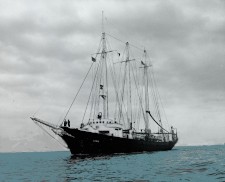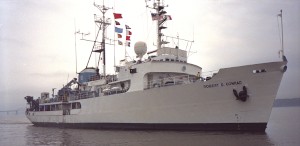History of the Core Repository
"A Core a Day"
Although Lamont Geological Observatory was not established until 1949, the earliest cores in the Repository collection were taken in 1947, on the R.V. ATLANTIS, by Maurice Ewing, Lamont’s founder and first director. Ewing believed that if Lamont gathered as many cores as possible, from as many places as possible, patterns would emerge that would reveal the geological history of our planet. Thus, the dictum came down: “A core a day." From the early 1950’s to the late 1980’s Lamont’s two ships, the R/V VEMA and the R/V ROBERT D. CONRAD, each logged over 1,609,344 km sailing the world's oceans under the Columbia University flag. And each vessel religiously took "A core a day". Every core was carefully archived and the tremendous number arriving at the Repository formed the core of what would quickly become the world’s largest collection of deep sea cores.
Scientists from all over the world have studied samples from the Repository’s vast number of cores and, in the last decade, use of the material has increased dramatically in direct response to increased interest in studying past climate. The Repository now includes 18,700 cores from 11,500 sites in all the major ocean basins, including the Arctic, as well as from many of the marginal seas. We are constantly adding to our collection as new material arrives every year from expeditions around the planet. It's a rare comprehensive library of Earth’s history. And it all began more or less by accident.

In July of 1947, Maurice Ewing, newly hired by the great but then shipless Columbia University, was given the chance to use Woods Hole Oceanographic Institution's R/V Atlantis for two long, precious months. Seizing the opportunity, he stocked the ship with every instrument he could make or find to explore every facet of the ocean. Although he was a geophysicist, not an oceanographer or marine biologist, he also took along an instrument called the Stetson corer, invented by a WHOI scientist named Henry Stetson.
"I felt an obligation, with an expedition entrusted to me for two months, to get data of every conceivable kind," Ewing said. To man the device, Ewing also took along Stetson's assistant, David Ericson. The Atlantis headed south, with scientists and crew taking measurements "of every conceivable kind" all along the way, until they approached Bermuda. There, the echo sounder aboard ship told them that water depths were gradually decreasing and they eventually found themselves over the flat top of a two-mile high seamount.
Here, Ewing decided, was a good place to try to get his first core, one that many years later he would still refer to as “one of the best of my life." These early time-consuming coring experiences led Ewing to realize that he had to find a way to make coring more efficient and economical. Thus, Ewing made his own device — the Ewing Piston Corer — a design still used today that combined the best features of then-existing devices. Ewing's rig took plugs of mud 6 to 9 meters long compared to the ~3 meters typical with existing corers. Likewise, instead of an expensive core barrel turned on a lathe, Ewing made his corer out of 6.35 cm steel boiler tube, an inexpensive commercial pipe, allowing him to stock his ship with spare parts and quickly repair or replace lost coring rigs.

In 1953, Lamont acquired the Vema and Ewing’s coring program began in earnest. Wherever the Vema went, and later wherever Lamont's second ship, the Robert D. Conrad, went, crews took at least one core each day, and often many more. They were guided to potentially interesting coring spots by Lamont's depth recorders, which precisely displayed seafloor topography. Ewing's credo was that the ship may never again get back to that's day location in the vast ocean, so grab a core while you had the chance.
He had neither the means nor the intention to work up all the cores the instant they arrived back at Lamont. And he ignored scientists who complained that he was wasting time and money by taking too many cores. He replied that he would stop when he found two cores that were alike. He instinctively knew that the mud brought up from beneath the ocean floor held stories, more stories than he, or all the oceanographers in the world working together, could possibly decipher. He decided to establish a library of cores so that researchers, now or in the future, could have specimens to study — with a fresh perspective or a more sophisticated instrument, perhaps — to discover something new.
Seeing the vast potential, both in the cores and in Ewing's zeal, Ericson left Woods Hole for the newly established Lamont Geological Observatory, becoming its first core specialist. When he first arrived at Lamont, he laid out his cores on a table under chandeliers in the Lamont family's former dining room. But the room was quickly overwhelmed by the core-a-day pace.
Jack Nafe, a Columbia faculty member and Lamont scientist, lived with his family in a cottage on the Lamont grounds and had been given one the Lamont's eight-car garages. Ewing asked if he could store some deep-sea cores in Nafe's garage, promising absolutely that it would be for just one year. Nafe never got his garage back. The cottage he lived in is now called "Nafe House," but his garage became Lamont's first core repository.

The cores kept coming in. In the 1960s and 1970s, Lamont had two ships at sea, circling the globe and taking a core a day. The ship's captains competed to see who could take the most. One year the Vema was out for 288 days and recovered 381 cores; the Conrad was out 300 days and collected 250 cores. The Vema may have won that round, but later the Conrad brought in an incredible 437 cores on just one cruise. One year, 631 cores were returned to Lamont. Lamont ships continually set records for taking the most geographically northern and southern cores, cores from the deepest water, and the longest cores. One core taken in the central Pacific was an incredible 28.2m long!
The ships always had room for more cores, no matter how cramped accommodations were onboard. Vema's hold was crammed with perilous-looking wooden racks to store the long tubes of sediment while in transit. Everyone accepted that science always came first and comfort second.
Doc's idea of a core "library" quickly became a reality. Soon a second story was built over Nafe's one-time garage to house a laboratory dedicated to work on the deep-sea sediments, the first Core Laboratory. An open slit was constructed in the floor of the upper level so that long sections of core could be lifted up from the ground floor into the lab area.
Early core studies proved the existence of turbidity currents in the deep ocean, providing an explanation of how canyons are cut on continental shelves and how trans-oceanic cables were broken. Locked in the cores was also a wealth of climatic information. The field of paleoclimatology (the study of past climates) blossomed even more quickly because of the synergy created by the proximity of Lamont's budding geochemistry laboratory. In the early 1950s, Wallace Broecker and J. Laurence Kulp developed radiocarbon dating techniques that could date fossilized shells in Ericson's deep-sea cores. In the mid-1950s when Ericson and his associate Goesta Wollin identified an abrupt boundary in a core — marked by an abundance of shells from a species that thrived in warm water above it and none below it — they sent samples to Broecker and Kulp, who dated the boundary at 11,000 years ago, what we now recognize as the boundary that marks the end of the Earth's last glacial period and the beginning of the current warm epoch known as the Holocene Period.
Suddenly scientists could attach dates to various layers in the cores and establish a top-to-bottom chronology of events. They were further aided by evidence in the cores of magnetic reversals in Earth's magnetic field, whose timing was also quickly becoming established. Lamonters Neil Opdyke and James Hays, along with graduate students Billy Glass and John Foster, embarked on a mission to identify a record of magnetic reversals in the cores thus providing a geologic calendar on which climatic events could be superimposed.

But evidence from one core in one location, or even a few from several, could not make the case for how or why the entire Earth's climate changed. When the scientific community sought to answer the age-old question of what caused Earth's cycle of ice ages, they needed to correlate many cores from all over the Earth. Naturally, Lamont's Core Lab provided the unique resource.
The task was too daunting for one scientist. It required a wide range of expertise: geochemists, mineralogists, oceanographers, paleomagnetists and geophysicists. It was even too big for one institution. So Jim Hays and John Imbrie, a former Columbia and Lamont scientist who had recently moved to Brown University, concocted a plan quite along the lines of another Lamont tradition — organizing and guiding multidisciplinary, multi-institutional research efforts to tackle ambitious global scientific problems. Launched in 1971, it was called CLIMAP (for "Climate Mapping") and its mission was to reconstruct the history of ocean changes deep into the past.
A central CLIMAP office was established at Lamont to coordinate the activities of nearly 100 scientists from the United States and seven other countries. Analyzing the climatic signals from numerous cores, the CLIMAP team proved that changes in astronomical cycles (more specifically, changes in the Earth's eccentricity, precession and tilt) triggered Earth's glacial cycles. In 1976, Hays, Imbrie and Nicholas Shackleton of the Univeristy of Cambridge published their classic paper in the journal Science: "Variations in Earth's Orbit: Pacemaker of the Ice Ages."
What helped make, and continues to make, Lamont's Core Laboratory so valuable is the remarkable foresight of Ewing, Ericson and Wollin in the early days to carefully record essential information about each core. They developed a system for archiving the cores, which continues today at Lamont and has become the standard for subsequent collections.
(Adapted from: Lamont-Doherty Earth Observatory of Columbia University - Twelve Perspectives on the First Fifty Years 1949 – 1999, Chapter Six by Rusty Lotti Bond.)
LDCR Curators 1957-Present:
- Chuck Fray, 1957-1964
- Roy Capo, 1964-
- Dorothy Cook,
- David Turkel,
- Floyd McCoy
- Ramona “Rusty” Lotti, 1985-2011
- Nichole Anest, 2012-present
LDCR Directors:
- Maureen Raymo, 2011-2022
- Brendan Reilly, 2022-
